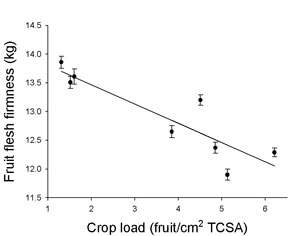Responses from chemical thinning can be unpredictable, making optimal management of crop load a difficult task.
Trying to juggle the currently available tools for crop load management with unstable spring weather conditions is a fine balancing act.
However, the combination of dormant pruning to remove weak spurs and unbalanced limbs—to open up the tree and reduce excess wood and bud load—followed by the use of a structured chemical thinning program during flowering and the early post-bloom period; and a final tidy-up hand thin, can give good results in maximising fruit quality and pack-out percentages while maintaining consistent yields.
An understanding of the many interacting factors influencing fruit thinning (Figure 1) will aid in developing a successful thinning program.
To maximise the benefits of any thinning program, good overall tree management is important. The greatest benefits are achieved where good management of all aspects of fruit production are employed. For example, where an orchard is subjected to water stress or nutrition is lacking, thinning is unlikely to substantially increase fruit size or quality.
Why is early crop load management so important?
Apple trees experience a natural ‘December’ drop, but this is insufficient to achieve optimum crop loads, fruit size and quality; or to prevent biennial bearing.
Flowers for the following year are initiated during spring and trees carrying heavy crop loads over this period will have reduced flower buds the following spring.
Hence to ensure regular bearing and optimise fruit quality we need to remove over 90% of the potential fruitlets within 6 weeks of bloom.
First 6 weeks after flowering
The first 6 weeks after flowering is also when cell division occurs in the developing fruitlets—maximising resources during this period of fruit growth will maximise both fruit size and internal quality.
Leaving excess fruit on the tree during this period is a waste of the trees resources, as growth is put into fruit that is later removed. It is more productive to channel this energy into fruit that will remain on the tree through to harvest. This is particularly important in drought years when water resources are scarce.
Crop load affects fruit size, firmness, sugar
The negative relationship between crop load and fruit size is well known, but high crop loads can also have a negative effect on fruit firmness (Figure 2) and sugar content (Figure 3).
Hence strategies such as the use of substantial removal of flower buds during dormant pruning, and application of blossom thinners early in the flowering period, provide an excellent chance of maximising fruit quality, and thus returns to the grower.
Stages in the thinning program
1. Pruning
Pruning during the dormant period should be considered the first stage of any thinning program. Well sized, high quality fruit are associated with open, healthy trees.
In apples, the best fruit occurs on younger spurs (2–4 year old). Canopies need to be opened up and trees kept young by appropriate pruning so that older spurs are removed and fruiting occurs on young wood.
Adequate light is also important for production of good quality fruit and initiation of strong flower buds—this is especially important in netted canopies.
Heading back of limbs should be avoided as this tends to invigorate the tree, instead, larger unbalanced branches should be removed completely.
Aiming for 6–7 branches per metre of tree height will open up the tree, resulting in improved bud initiation and better fruit quality as well as better spray penetration and access for harvesting.
(continues next month)
See this article in Tree Fruit July 2014






















